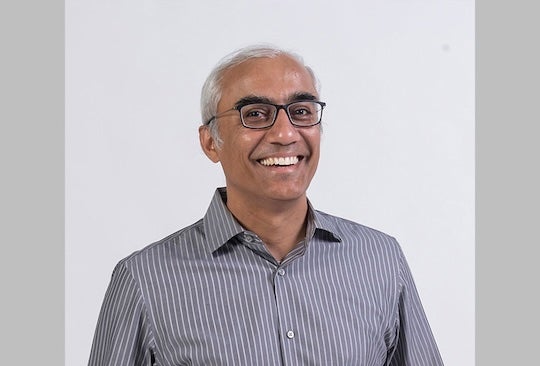Rice University professor Ashutosh Sabharwal will lead a research project dedicated to the design and development of a new open-access software-defined radio system, a modular platform for wireless networking, imaging and sensing that will significantly expand research capabilities and catalyze innovation in support of 6G wireless.

The project, titled “Houdini: Design and Development of an Open-Access very Diverse Spectrum Platform for Wireless Networking, Imaging and Sensing,” is supported through a $4.5 million award from the U.S. National Science Foundation (NSF).
In the global wireless industry, each decade brings a new generation of cellular standards, and the race to define and develop 6G technology is already in full swing. The emerging vision for 6G includes a 1000-fold improvement in network performance, the introduction of disruptive services like wireless sensing and imaging, and the integration of artificial intelligence to manage increasingly complex networks.
“There is a pressing need for high-performance, accessible research platforms to validate these ideas at the systems level,” said Sabharwal, Rice’s Ernest Dell Butcher Professor of Engineering and a professor of electrical and computer engineering. “Our goal is to create a ‘one box’ solution that can be reprogrammed to perform a wide range of tasks. It’s like a clean slate that can be used to test out many different ideas with just one piece of equipment. Think of it as Legos for wireless research ⎯ you can mix and match different pieces to create a custom setup that meets your specific needs.”
Conventional devices operating with radio frequency (RF) signals ⎯ for instance, cellular, radar, broadcast radio, Wi-Fi and Bluetooth ⎯ can typically only tap into a specific range of the electromagnetic spectrum.
“Some areas of the spectrum are exploited to send and receive information, as in the case of broadcast radio, while others are used for sensing ⎯ say, radars,” Sabharwal explained.
To access different ranges of the spectrum simultaneously, researchers currently have to build what Sabharwal calls “Frankenstein-like systems” that can only be used to explore a limited set of problems. The software-defined radio system Rice engineers plan to develop will be capable of supporting multiple radio modules simultaneously across diverse bands.
“In the cycle of wireless innovation, we often need to build prototypes to demonstrate new ideas,” Sabharwal said. “This can be expensive and slow: Picture trying to innovate tires or spark plugs, but needing to build the whole car in order to do so. We are building something that is intentionally broad-based so that anybody else who dreams of carrying out an experiment can do so.”
The system will deliver modules covering CBRS (3.55-3.7 GHz), X-band (8-12 GHz), Ku-band (12-16 GHz), Ka-band (26.5-28.35 GHz) and V-band (57-68 GHz). Uniquely, it will support X and Ku bands, which are not covered by any open-source research platforms. In maximal configuration, the system will be capable of addressing hundreds to thousands of antennas across the different bands. This flexibility will empower multiple research communities, from wireless networking to sensing and imaging, enabling the exploration of new directions in wireless technology.
Sabharwal has a track record of developing and disseminating open-source research platforms. His team developed WARP: Wireless Open Access Research Platform which was adopted worldwide and empowered hundreds of research projects in academic and corporate labs, and led to the startup Mango Communications. Most recently, his team has developed RENEW: Reconfigurable Eco-system for Next-generation End-to-end Wireless, the world’s first open-source massive MIMO network, which is now deployed at the University of Utah POWDER testbed.
“The second objective of the project is to educate the next generation of researchers and innovators. Turns out tools that can be used for diverse research are also very good for teaching and training across many courses,” Sabharwal said, adding that the team plans to deploy a diverse set of pedagogical approaches, from documentation to hands-on workshops and conference demos.
“This forward-looking platform will empower the research community to explore new possibilities in wireless networking, sensing and imaging,” said Deepankar Medhi, program director in the NSF’s Computer and Network Systems Division. “By Providing a versatile tool for diverse research fields, we hope to bridge the gap between groundbreaking applications and real-world wireless systems, ultimately driving the adoption of 6G and beyond technologies.”
In addition to Sabharwal, other Rice PIs on the project are Joseph Cavallaro, a professor of electrical and computer engineering and computer science, and Rahman Doost-Mohammady, assistant research professor of electrical and computer engineering. Other PIs on the project are Xinyu Zhang, University of California San Diego; Kaushik Chaudhury, University of Texas at Austin; Nick Laneman and Bertrand Hochwald, University of Notre Dame.
- Award information:
-
Project title
Houdini: Design and Development of an Open-Access very Diverse Spectrum Platform for Wireless Networking, Imaging and Sensing
Award number
2346550 - Image downloads:
-
https://news-network.rice.edu/news/files/2024/08/000_AS_photo.jpg
CAPTION: Ashutosh Sabharwal is the Ernest Dell Butcher Professor of Engineering and a professor of electrical and computer engineering at Rice University. (Photo courtesy of Rice University)

